Program Description
The Atlantic Humpback Dolphin (Sousa teuszii) is a critically endangered species that lives only in nearshore coastal waters on the western side of the African continent. These dolphins live in small populations along the coast from Morocco to Namibia. In Senegal, we are fortunate to have the largest population of this species population living in the Delta Saloum region of the central coast, primarily in mangrove channels and the nearshore coastal zone. This population likely also moves into The Gambia.
The African Aquatic Conservation Fund leads research and conservation activities in Senegal and is a member of the Consortium for the Conservation of the Atlantic Humpback Dolphin (CCAHD). Beginning in 2021, we have developed the first long-term photo identification catalog of individual dolphins (based on marks and scars on their dorsal fins) which also helps us to estimate the size of the population and understand their habitat use, passive acoustic monitoring to document Atlantic Humpback Dolphin vocalizations and habitat use, a genetics study which will also help us to estimate population size, the health of the population, and relatedness to other populations across Africa, and carcass sampling to study dolphin physiology and baseline health.
Our project also supports African researchers from other range countries to come to Senegal for training in field research techniques to study Atlantic Humpback Dolphins, and we partner with Delta Saloum National Park and four marine protected areas (Gandoule, Sangomar, Palmarin, and Bamboung) to share information and work together towards conserving this iconic species.
Our staff are part of CCAHD working groups that focus on field research, population health, genetics, acoustics, threat mitigation, interview surveys, and educational outreach.













